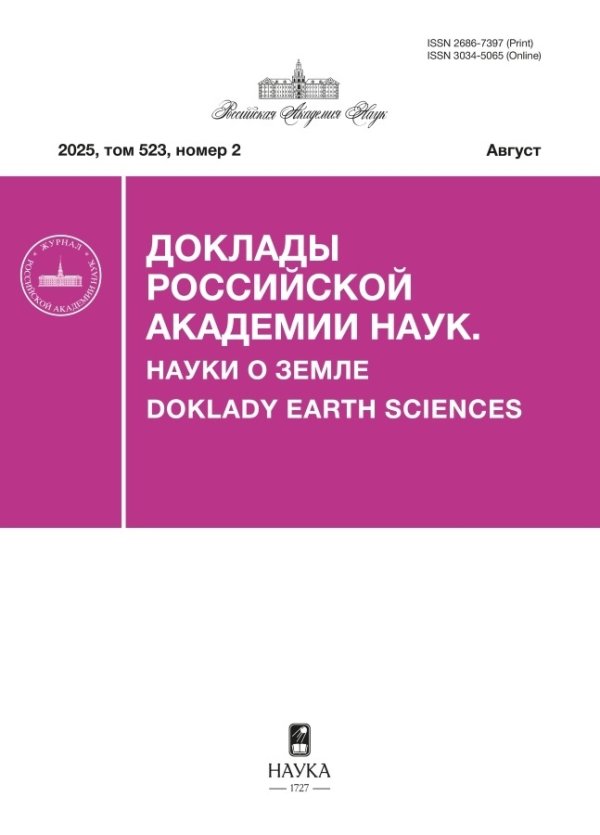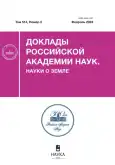Ilei fluorite-phenakite ore phenomenon (Eastern Sayan): contribution of Devonian riftogenic magmatism to formation of Eastern Sayan rare metal metallogenic zone
- Authors: Lykhin D.A.1, Vorontsov A.A.2, Yarmolyuk V.V.1
-
Affiliations:
- Institute of Geology of Ore Deposits, Petrography, Mineralogy, and Geochemistry, Russian Academy of Sciences
- A.P. Vinogradov Institute of Geochemistry, Siberian Branch of the Russian Academy of Sciences
- Issue: Vol 514, No 2 (2024)
- Pages: 251-262
- Section: METALLOGENY
- Submitted: 31.01.2025
- Published: 12.09.2024
- URL: https://vestnik.nvsu.ru/2686-7397/article/view/650085
- DOI: https://doi.org/10.31857/S2686739724020087
- ID: 650085
Cite item
Abstract
Within the Altai-Sayan fold region, covering the territory of the East Tuva Highlands and Eastern Sayan, one of the richest rare metal provinces of Russia is concentrated. Deposits of rare metals, elements and lands formed within its limits have different ages and arose in different geotectonic environments and in different metallogenic eras. They are associated with the introduction of alkaline rock masses that are common along the fault system between the caledonids of the Altai-Sayan fold region and the Tuvino-Mongolian Precambrian superterrane. Their distribution range is also defined as the East Sayan rare metal metallogenic zone (VSMZ), which arose due to the impact of mantle plumes on the southwestern framing of the Siberian platform. Geochemical and geochronological studies were carried out at the Ilei fluorite-phenakite ore show. Ore development resulted from the introduction of Ognite complex granitoids into the limestones of the Mongoshin formation, which became a geochemical barrier to the igneous fluid enriched with fluorine and Be. Geochronological Rb-Sr and Ar-Ar studies have shown that subalkaline granites, as well as acidic volcanites of the Ilean sequence, are of Middle Devonian age ~ 390 million years, which is consistent with age estimates for the rocks of the Ognite complex. Thus, the same age of magmatism and ore formation at the Ilei ore phenomenon indicates the contribution of Devonian magmatism to the formation of rare metal mineralization within the VSMZ.
Full Text
About the authors
D. A. Lykhin
Institute of Geology of Ore Deposits, Petrography, Mineralogy, and Geochemistry, Russian Academy of Sciences
Author for correspondence.
Email: lykhind@rambler.ru
Russian Federation, Moscow
A. A. Vorontsov
A.P. Vinogradov Institute of Geochemistry, Siberian Branch of the Russian Academy of Sciences
Email: lykhind@rambler.ru
Russian Federation, Irkutsk
V. V. Yarmolyuk
Institute of Geology of Ore Deposits, Petrography, Mineralogy, and Geochemistry, Russian Academy of Sciences
Email: lykhind@rambler.ru
Academician of the RAS
Russian Federation, MoscowReferences
- Добрецов Н. Л., Беличенко В. Г., Бутов Ю. П. и др. Геология и рудоносность Восточного Саяна. Новосибирск: Наука. 1989. 127 с. http://www.ipgg.sbras.ru/ru/science/publications/monography-geologiya-i-rudonosnost-vostochnogo-sayan-1989-010464
- Гордиенко И. В., Рошектаев П. А., Гороховский Д. В. Окинский рудный район Восточного Саяна: геологическое строение, структурно-металлогеническое районирование, генетические типы рудных месторождений, геодинамические условия их образования и перспективы освоения // ГРМ. 2016. Т. 58. № 5. С. 405–429. https://uchimsya.com/a/ns2O0AsW
- Yarmolyuk V. V., Kuzmin M. I., Ernst R. E. Intraplate geodynamics and magmatism in the evolution of the Central Asian Orogenic Belt // Journal of Asian Earth Sciences. 2014. V. 93. P. 158–179. https://elibrary.ru/uezicf
- Ярмолюк В. В., Лыхин Д. А., Козловский А. М. и др. Состав, источники и механизмы формирования редкометальных гранитоидов позднепалеозойской Восточно-Саянской зоны щелочного магматизма (на примере массива Улан-Тологой) // Петрология. 2016. Т. 24. № 5. С. 515–536. https://doi.org/10.7868/S0869590316050083
- Лыхин Д. А., Ярмолюк В. В., Воронцов А. А. Возраст, состав и источники пород и руд Окуневского флюорит-лейкофанового месторождения (Западный Саян): К оценке вклада магматизма в формирование рудной минерализации // ГРМ. 2019. Т. 61. № 5. С. 37– 61. https://elibrary.ru/item.asp?id=41332166
- Владыкин Н. В., Алымова Н. В., Перфильев В. В. Геохимические особенности редкометальных гранитов Зашихинского массива, Восточный Саян // Петрология. 2016. Т. 24. № 5. С. 554–568. https://doi.org/10.7868/S086959031605006X
- Воронцов А. А., Сандимиров И. В. Девонский магматизм хребта Кропоткина (Восточный Саян) и источники базальтов: геологические, геохимические и изотопные Sr-Nd данные // Геология и геофизика. 2010. Т. 51. № 8. С. 1073–7087. https://elibrary.ru/item.asp?id=15168156
- Лыхин Д. А., Ярмолюк В. В., Сальникова Е. Б. и др. U-Pb возраст редкометальных щелочных гранитов месторождения Снежное: к оценке возрастной однородности гранитоидов огнитского комплекса (Восточный Саян) // Докл. РАН. Науки о Земле. 2022. Т. 506. № 2. С. 148–157. https://elibrary.ru/item.asp?id=49421256
- Генетические типы гидротермальных месторождений бериллия / Гинзбург А. И., Заболотная Н. П., Куприянова И. И. и др. М.: Недра. 1975. https://search.rsl.ru/ru/record/01006918784
- Куприянова И. И., Шпанов Е. П. Бериллиевые месторождения России // М.: ВИМС. 2011. 353 с. https://search.rsl.ru/ru/record/01005391656
- Sun S.S., McDonough W. F. Chemical and isotopic systematic of oceanic basalts: implications for mantel composition and processes: magmatism in ocean basalts / Eds. A. D. Saunders, M. J. Norry. Geolog. Soc. London Spec. Publ. 1989. V. 42. P. 313–346. doi: 10.1144/GSL.SP.1989.042.01.19.
- Pearce Y. A., Harris N. B.W., Tindle A. G. Trace element discrimination diagram for the tectonic interpretation of granitic rock // J. Petrol. 1984. V. 70. P. 956–983. https://doi.org/10.1093/petrology/25.4.956
- Саватенков В. М., Морозова И. М., Левский Л. К. Поведение изотопных систем (Sm-Nd, Rb-Sr, K-Ar, U-Pb) при щелочном метасоматозе // Геохимия. 2004. № 10. С. 1027–1049. https://doi.org/10.1093/petrology/25.4.956
- Котов А. Б., Ковач В. П., Сальникова Е. Б. и др. Этапы формирования континентальной коры центральной части Алданской гранулито-гнейсовой области: U-Pb и Sm-Nd изотопные данные по гранитоидам // Петрология. 1995. Т. 1. № 1. С. 97–108. https://elibrary.ru/gkqfgr
- York D. Least-sguares fitting of a straight line. Can // J. Physics. 1966. V. 44. P. 1079–1086 https://studylib.net/doc/18489580/york-d.-least- squares-fitting-of-a-straight-line
- Steiger R. H., Jager E. Subcomission of Geochronology: convension of the use of decay constants in geo- and cosmochronology // Earth Planet. Sci. Lett. 1977. V. 36. № . 2. P. 359–362. https://doi.org/10.1016/0012-821X(77)90060-7
- Травин А. В., Юдин Д. С., Владимиров А. Г. и др. Термохронология Чернорудской гранулитовой зоны (Ольхонский регион, Западное Прибайкалье) // Геохимия. 2009. Т. 11. С. 1181–1199. https://elibrary.ru/item.asp?id=12951863
- Государственная геологическая карта Российской федерации масштаба 1:200000 N-47-XXIX (Алаг-Шулун). Объяснительная записка. ФГБУ “ВСЕГЕИ” Москва. 2019. https://www.geokniga.org/sites/geokniga/files/map comments/n-47-xxix-alag-shulun-gosudarstvennaya-geologicheskaya-karta-rossiyskoy-fed.pdf
- Воронцов А. А., Ярмолюк В. В., Сандимирова Г. П. Базальт-трахириолит-комендитовая ассоциация хребта Кропоткина (Восточный Саян) и проблема девонского рифтогенеза в южном обрамлении Сибирской платформы // ДАН. 2008. Т. 423. № 2. С. 222–227. https://elibrary.ru/item.asp?id=11602255
Supplementary files














